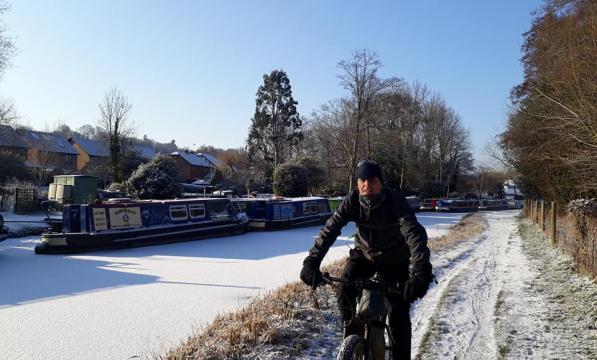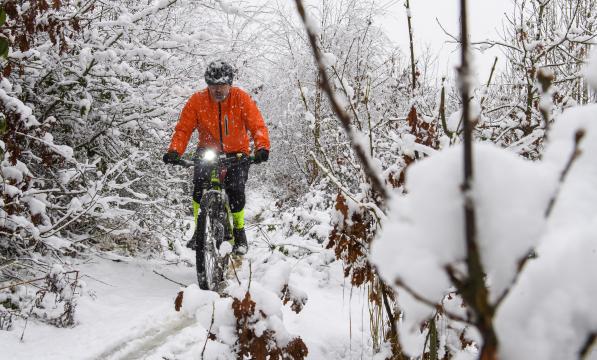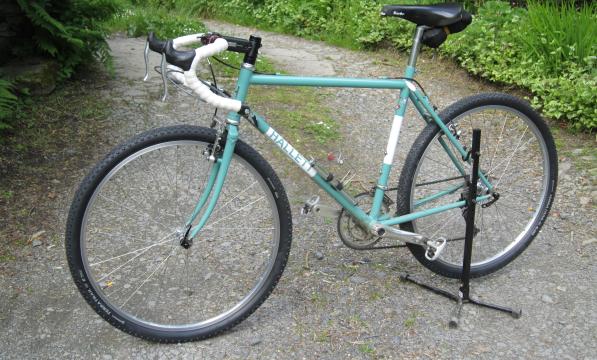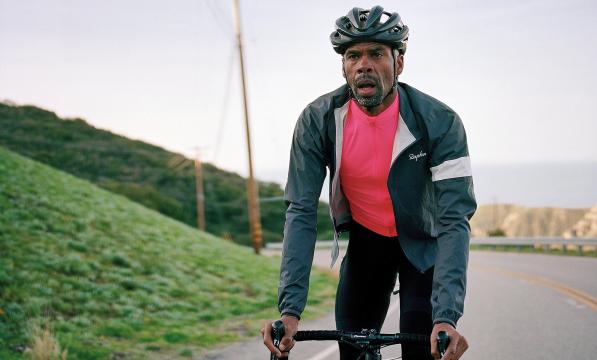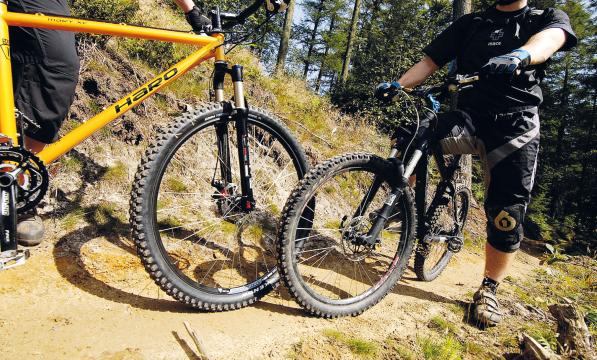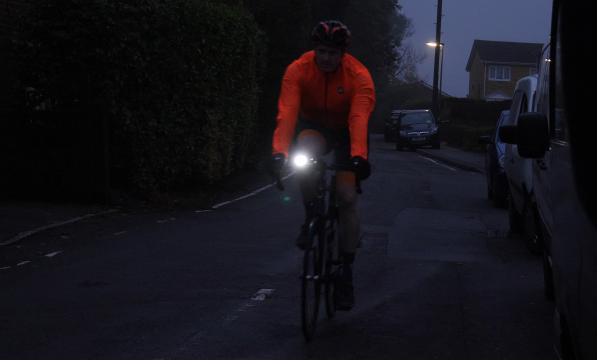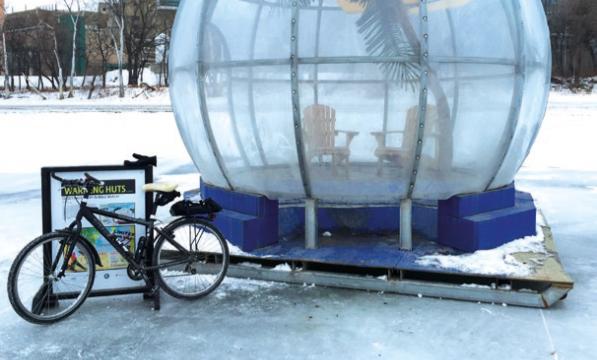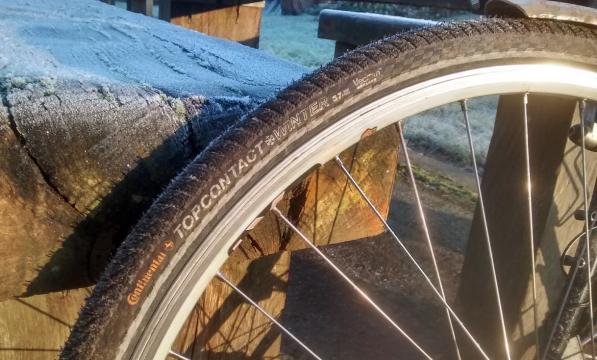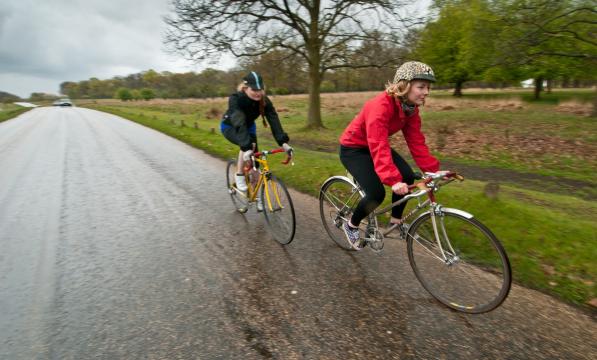Cycle tyres for winter, snow and ice

Bespoke bike maker Liz Colebrook explains the difference between a studded cycle tyre and a winter tyre and the reasons why you might want to fit them to your bike in winter.
For years, when it snowed I regretted not having splashed out on a pair of studded tyres. Last year, I committed and fitted some. Is it worth the expense for a few weeks every year? I’d say so, even if just for the smug factor. Seriously though, it will depend on your environment, occupation and travel options.
What is a studded tyre?
Light it isn’t, but armoured it certainly is. Not only does it feature two to four rows of steel studs fitted into the rubber at regular intervals, but it’ll also boast a medium to high rating for puncture resistance. Each tyre can approach weights of nearly 1kg, not surprising when some contain over 240 studs.

How do studded tyres help?
The studs dig tenaciously into the ice on the road surface. However, if there’s a lot of snow on top of the ice, the studs may not penetrate far enough down to the ice layer and you’re likely to fishtail about. But my goodness the sensation of riding on ice is probably the closest you’ll get to walking on water.
Imagine the usual treachery of an icy commute and the astonishment of your colleague when you announce that you cycled in.
However be careful when you dismount, as a friend who is a hardy commuter found out. Riding his new studded tyres he confidently rounded the final corner ‘velcro-ed’ to the road and arrived at work super chuffed, he’d made it….but promptly fell base over apex dismounting as his shoes weren't as good as studded tyres.
I recently recommended studded tyres to an older rider at increased risk of slipping on his shaded, steep and mossy driveway. Although not just for the ice, this lifelong cyclist who is facing dementia, manages with the right bike to keep doing something extremely familiar with extra security for as long as he can.
What are the drawbacks?
Studded tyres on tarmac sound like you’re driving on loose chippings or the crackle of space dust popping candy on your tongue. They may be heavy but when it’s icy, enjoying the pleasure of staying upright more than compensates.
Tyre pressure for studded tyres
Run with a little less pressure than usual for a good contact patch enabling as many studs as possible to claw into the icy road surface. For non-icy days, increase tyre pressure so fewer studs make contact. This also reduces stud loss when studs get snagged occasionally in the rough road surface (replacement studs and fitting tool are available).
Do you need studded tyres?
In a nutshell, you turn your bike into a tank but at least you can ride it. Being able to journey longer distances rather than walking with crampons will be worth the time it takes to swap tyres – especially if working from home is not an option.
What is a winter tyre?
A winter tyre offers two key benefits in exchange for a percentage loss of performance. Increased puncture protection and improved grip in cold and wet conditions.

Puncture resistance
As glass and sharps will stick to wet tyres, the chance of puncturing is increased. No one relishes stopping in cold, wet and dark conditions to fit a new tube and search for the cause. Plus there’s the safety issue of doing this on the roadside. Winter tyres buy peace of mind and extra amour.
Grip
Grip depends on where and how you ride. If you want to continue riding along a canal tow path, switching to an ‘adventure’ tyre may be a better option with tread patterns that interface with the ground more like cogwheels working together. A tread profile with open blocks ensures riding safety in wet, slushy, snow, muddy winter conditions.
Research and development in tyre construction is continually evolving to optimise performance across so many different disciplines, styles of riding and wheel systems (tubeless). I would always say it’s worth spending on your wheelset and tyre set up. However, if the pressure is incorrect, any benefit will be drastically reduced so check the tyre sidewall and use a pump with a gauge.
Wet roads and tread pattern
Although the science says bicycles don’t need water evacuation tread patterns for the same reasons as cars, we tend to feel psychologically reassured by a more obvious tread pattern riding in winter. The softer the tread the better the grip but the faster it will wear, hence multi-compound layer-ups using combinations of rubber and synthetic compounds in different parts of the tyre.
As the temperature drops, rubber can ‘harden’ effectively reducing grip. Schwalbe four season tyres employ a soft silica compound with very good grip properties that continue to work well even at minus temperatures acting a bit like anti-freeze - clever stuff.
What is the worst type of tyre for cycling in winter?
A typical performance road tyre designed for competition. Save these for good weather as they offer minimal puncture protection, super supple sidewalls and use rubber and synthetic compounds designed for dry conditions.
Old tyres that have started to harden and develop crack-like fissures in the tread/sidewalls making them more vulnerable to sharps and punctures. Inflate to pressure watching carefully to see if this is happening, if so, chances are your tubes and rim tapes will need replacing too.
Conclusion
Winter riding demands more tyre armour. Roads are usually wetter and often strewn with debris washed up from the rainfall. Winter tyres offer increased puncture resistance, better grip and peace of mind. No tyre will prevent you from slipping on layers of wet leaves or wet metal drain and inspection covers, but an awareness of these potential dangers and good riding technique will go a long way towards reducing your chances of this.
Risk assess your route as the seasons change and consider winter tyres for wet, cold, slush and mud or studded tyres for snow and ice.

